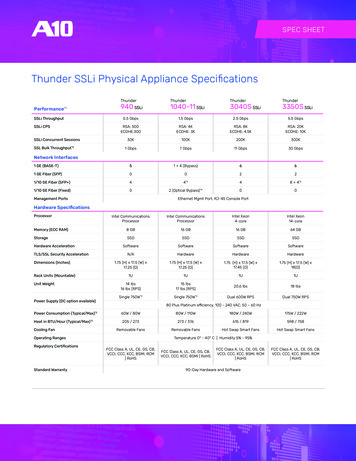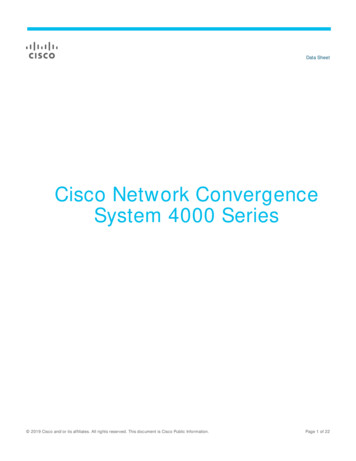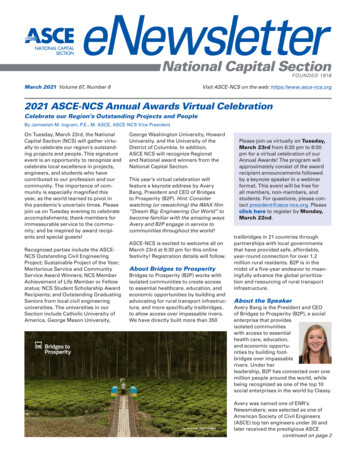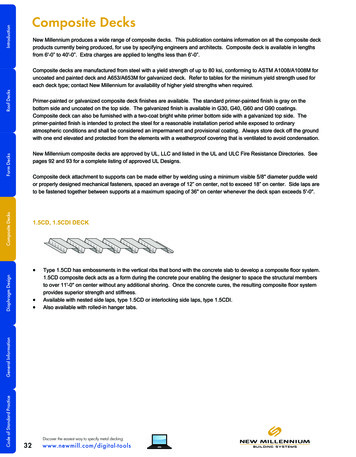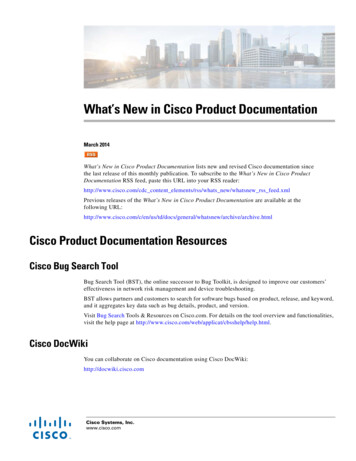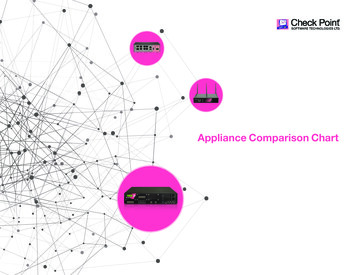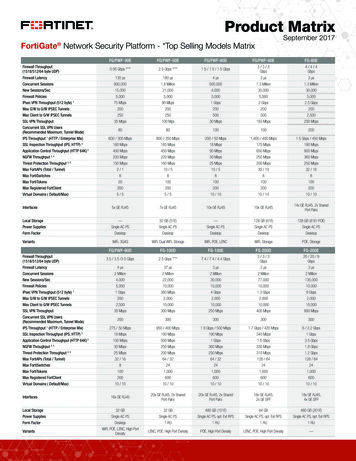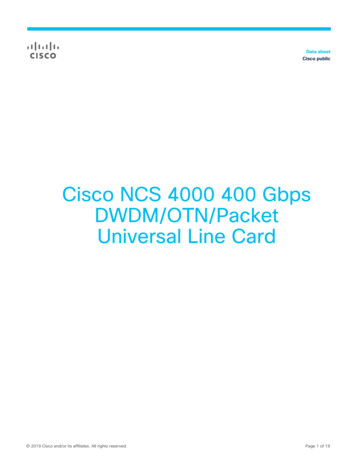
Transcription
Data sheetCisco publicCisco NCS 4000 400 GbpsDWDM/OTN/PacketUniversal Line Card 2019 Cisco and/or its affiliates. All rights reserved.Page 1 of 19
ContentsProduct overview3Challenge and solution3Product description5Network applications - Programmable ethernet transport12Licensing13Product specifications13Other specifications15For more information18Cisco environmental sustainability18Warranty information19Cisco services for migrating converged IP Optical solutions19Cisco Capital19 2019 Cisco and/or its affiliates. All rights reserved.Page 2 of 19
Product overviewThe Cisco Network Convergence System (NCS) 4000 400 Gbps Universal line card converges DenseWavelength-Division Multiplexing (DWDM), Optical Transport Networking (OTN) and Packet services into asingle line card. The Universal line card can be provisioned to provide any combination of 10 Gbps, 40Gbps and 100 Gbps grey services as well as 100 Gbps, 150 Gbps and 200 Gbps DWDM services. Thecard has been engineered to be a Universal line card: all services and applications supported by NCS 4000can be efficiently deployed using just this card, without stranding any bandwidth.The Cisco NCS 4000 Universal line card dramatically enhances system density and performancesdelivering 400 Gbps capacity per slot (6.4 Tbps per NCS 4016 chassis), and the ability to map trafficacross the different ports on the faceplate. Selecting the type of pluggable optics, on a port-by-port basis,defines the unique profile of each Universal line card: Up to 2x 200 Gbps Dense Wavelength-Division Multiplexing (DWDM) wavelengths using theCFP2 ports Up to 4x 100GE/OTU4 Client interfaces using the QSFP28 ports Up to 10x 40GE/OTU3 Client Interfaces using the QSFP /QSFP28 ports Up to 40x 10GE/OTU2 Client Interfaces using the QSFP /QSFP28 ports Any mix and combination of the aboveThe Cisco NCS 4000 400 Gbps Universal line card simplifies the integration and transport of 10 Gbps, 40Gbps and 100 Gbps Ethernet and Optical Transport Unit (OTU) services for service provider and enterprisenetworks.Figure 1.Cisco NCS 4000 400 Gbps WDM/OTN/Packet Universal Line CardChallenge and solutionA growing number of network events are generated every day as billions of programmable devicesconnect to one another over the Internet. This imposes new expectations on network performance. As theInternet of Everything (IoE) builds, the role of the network to support, manage, and control theseprogrammable device-driven events becomes critical as these tasks rapidly surpass the capacity of manualintervention. Networks must evolve to support new levels of virtualization, programmability, andperformance. Networks must now scale not just bandwidth, but also compute and control functions tomanage policies and generate the proper responses within the expected timeframe. 2019 Cisco and/or its affiliates. All rights reserved.Page 3 of 19
With just one line card, the Cisco NCS 4000 400 Gbps DWDM/OTN/Packet Universal line card, networkoperators are able to grow with programmability, scale, and convergence across the photonic, OTN, andpacket switching layers. Combined, the Cisco NCS 4000 and the 400 Gbps Universal line card providenetwork operators with an enhanced architectural approach to profitably deliver innovative and flexibleservices across an evolved programmable network, while simultaneously increasing resiliency anddramatically reducing capital expenditures.BenefitsThe Cisco NCS 4000 400 Gbps DWDM/OTN/Packet Universal line card provides multiple benefits in termof Flexibility, Performance, Savings and Density improvements.FlexibilityA single 400 Gbps Universal line card providing any mix of photonic, OTN and Packet services, supportingrates that include 10 Gbps, 40 Gbps, 100 Gbps grey services. The NCS 4000 Universal line card alsoprovides two 200 Gbps 16-QAM DWDM Long Haul transmission ports through the CFP2 ACO pluggables.Performance improvementIncorporating the latest generation of Digital Signal Processor (DSP) technology dramatically increases theperformance of 100 Gbps QPSK and 200 Gbps 16-QAM optical transport. Support of 8-QAM modulationformat will also further enhance the capability of the NCS 4000 system, enabling the right tradeoff betweenfiber capacity and un-regenerated transmission distance.SavingsThe ability to configure multiple grey and DWDM ports from a single line card dramatically reducesoperational costs. With only one line card to maintain, forecasting and ordering are greatly simplified,sparing is significantly reduced, and designing network expansion is far less complex, resulting inaccelerated time-to-market for new services.DensityConfiguring a single NCS 4016 chassis with sixteen 400 Gbps Universal line cards delivers 6.4 Tbps ofgrey, OTN and Packet service capacity, including thirty-two High Speed Coherent DWDM Interfaces, all ina single 24 Rack Unit (RU) chassis - 12.8 Tbps in one full rack.Figure below shows the deployment flexibility of the Universal OTN/DWDM/MPLS linecard with degrees offlexibility across technology and bandwidth requirements to enable the cost savings and allow for a smoothtechnology migration and adoption. 2019 Cisco and/or its affiliates. All rights reserved.Page 4 of 19
Product descriptionThe Cisco NCS 4000 400 Gbps DWDM/OTN/Packet Universal line card provides two High Speed CFP2based DWDM ports, six QSFP based ports supporting 40 Gbps or four 10 Gbps services, and four QSFP or QSFP28 based ports that can support 40 Gbps, four 10 Gbps QSFP or 100 Gbps services.The Universal line card supports 400 Gbps of OTN switching functionality (from ODU-0 up to ODU-4) aswell as of Carrier Ethernet and MPLS switching functionalities and is directly connected through thebackplane to the NCS 4000’s Agnostic Switching Fabric line card.WDM interfacesThe Cisco NCS 4000 400 Gbps DWDM/OTN/Packet Universal Line Card provides two High Speed CFP2based DWDM ports capable of transmitting 100 Gbps, 150 Gbps or 200 Gbps carriers, which can betransported independently across the network or combined into a 400 Gbps dual-wavelength superchannel.Each High Speed port can be configured to support: 100 Gbps Coherent DWDM transmission with QPSK modulation Hardware support for 150 Gbps Coherent DWDM transmission with 8-QAM modulation 200 Gbps Coherent DWDM transmission with 16-QAM modulationThe different modulation schemes listed above are software configurable to deliver the ideal tradeoffbetween reach and transport capacity per wavelength. The primary modulation schemes leveraged todayfor DWDM transmission are QPSK, 8-QAM and 16-QAM. The constellation diagrams for these modulationtypes are illustrated in Figure 2. 2019 Cisco and/or its affiliates. All rights reserved.Page 5 of 19
Figure 2.Constellation Diagrams for QPSK, 8-QAM and 16-QAMWhile higher order modulation formats provide higher spectral efficiency, they generally require moreOptical Signal-to-Noise Ratio (OSNR) resulting in reduced un-regenerated reach.Figure 3 shows the relationship of reach vs. spectral efficiency for QPSK, 8-QAM and 16-QAM modulationwhen using ITU-T G.652 SMF or ITU-T G.655 LEAF fiber and with varying channel spacing.Figure 3.The Chart Provides Capacity (Tbps) and Spectral Efficiency (bit/s/Hz) VS Maximum Reach (Lmax) for differentmodulation schemes. SMF is represented in solid lines and LEAF is represented in dashed lines. 2019 Cisco and/or its affiliates. All rights reserved.Page 6 of 19
Cisco Coherent Transmission technology greatly enhances the reach and reliability of transportperformance while providing the flexibility to select the optimal modulation scheme for a specificapplication. The primary benefits of Cisco Coherent technology includes: Very strong OSNR performance Outstanding chromatic dispersion robustness, avoiding any additional cost related to opticalchromatic dispersion compensation equipment Extended polarization mode dispersion robustness Very high spectral efficiency, allowing wavelengths to be transmitted across a large number ofReconfigurable Optical Add/Drop Multiplexers (ROADMs)Trunk CFP2 WDM pluggablesThe Cisco NCS 4000 400 Gbps DWDM/OTN/Packet Universal line card supports Analog Coherent Optical(ACO) CFP2 WDM pluggables, featuring software-provisionable tunability across the full C-band. Both 50GHz channels spacing (supporting 96 Nyquist shaped wavelengths) and grid-less 100MHz tuning steps aresupported. Different modulation schemes are also software configurable as described earlier.Client portsThe Cisco NCS 4000 400 Gbps DWDM/OTN/Packet Universal line card supports the following clientservices: 10 Gbps (leveraging 4x10 Gbps QSFP ) - 10GE LAN-PHY, OTU-2, OC-192/STM-64 services areavailable. and 8G/16G FC services are planned for in a future software release. 40 Gbps (leveraging 40 Gbps QSFP ) - 40GE LAN-PHY and OTU-3 services are available. 100 Gbps (leveraging 100 Gbps QSFP28) - 100GE and OTU-4 services are available.Software configurable FEC optionFour different Software Defined Forward Error Correction (SD-FEC) options are supported by the CiscoNCS 4000 400 Gbps DWDM/OTN/Packet Universal line card: 25% Overhead (OH) for maximum performance. 25% Overhead (OH) with Differential Encoding. 15% Overhead (OH) to minimize filtering impairment. 15% Overhead (OH) with Differential Encoding.The configuration of the SD-FEC overhead can be done through the available management interfaces.OTN switchingThe Cisco NCS 4000 400 Gbps DWDM/OTN/Packet Universal line card provides full ITU G.872-compliantOTN switching functions. It supports ODU-0 to ODU-4 multilayer switching and grooming including nestedOTN switching. The Universal line card is capable of supporting up to 2-level ODU-4, ODU-3, ODU-2,ODU-1, ODU-0, and ODU-Flex switching functions by interconnecting with the centralized agnostic switchfabric. Ethernet Signals are mapped into ODU container as described in Table 1. 2019 Cisco and/or its affiliates. All rights reserved.Page 7 of 19
Table 1.OTN line-card mappingRateMapping10 Gigabit EthernetG.Sup43 7.1/G.709 17.2.4: CBR10.3G à OPU2eG.709 17.4: GFP-F à OPU2G.Sup43 7.3/G.709 17.4.1: GFP-F à Extended OPU40 Gigabit EthernetBMP or GMP over OPU3CBR ir GFP-F over OPUF100 Gigabit EthernetGFP-F or GMP over OPU4CBR or GFP-F over OPUFThe Cisco NCS 4016 system, equipped with 400 Gbps DWDM/OTN/Packet Universal line card, supportssingle-chassis switching of 6.4 Tbps fully non-blocking at ODU-0 level (5120 ODU-0 or ODU-Flex dataunits) while the Cisco NCS 4009 system supports single-chassis switching of 3.6 Tbps fully non-blockingat ODU-0 level (2880 ODU-0 or ODU-Flex data units).The NCS 4000 is ITU G.709 Operations, Administration, and Maintenance (OAM)-compliant, with six levelsof Tandem Connection Monitoring (TCM) support.OTN configuration, provisioning, and protection are managed by a Generalized MPLS (GMPLS)-based OTNcontrol plane supporting an embedded User-Network Interface (UNI) as the communication interfacebetween control planes managing different transport layers within the same system. The control-planeinstance runs inside the optical domain (overlay network scenario), providing an external UNI interface toclient nodes for invocation of on-demand services.As an extension of the Cisco nLight Control Plane Protocol, an OTN circuit between ingress and egressnodes can be established statically or dynamically using Resource Reservation Protocol (RSVP) signaling.An OTN circuit is established and maintained as a Label Switched Path (LSP) between the ingress andegress LSRs, switched through transit LSRs.Packet featuresThe Cisco NCS 4000 400 Gbps DWDM/OTN/Packet Universal line card supports packet features asdefined in Table 2 on a per-ODU, or on a per-interface basis.Table 2.Packet feature-setFunctionalityFeatured mechanismLayer 2 transportCarrier Ethernet, MPLSLayer 2 and Layer 2 servicesCarrier Ethernet: EPL, EVPLMPLS-TE: P2P circuits (VPWS)Associated Bi-directional Channel with Sub-50ms protectionEthernet virtual circuitIEEE 802.1q, IEEE 802.1adIGPOSPF-TE and IS-ISQuality of service (per port)Policing, queuing/shapingSingle-rate, dual-color policer (1R2C)Dual-rate, three-color policer (2R3C) 2019 Cisco and/or its affiliates. All rights reserved.Page 8 of 19
FunctionalityFeatured mechanismEthernet OAMIEEE 802.1ag CFMIEEE 802.3ah EFMITU-T G.8261Sync-EITU-T G.8262Table 3 list the scale numbers for the above functionalityTable 3.Scale numbersParameterScaleTotal number of 10 GigE interfaces40 (LC)/640 (Sys)Total number of 100 GigE interfaces4 (LC)/64 (Sys)Total number of 100 GigE OTN interfaces4 (LC)/64 (Sys)Total number of Ethernet Virtual Circuits (EVCs)16,000Total number of MPLS Bidirectional Associated LSPs2,000Total Number of MPLS-TE LSPSTotal number of MPLS pseudowire (VPWS)1,000Total number of MPLS Midpoints32,000Total number of IEEE 802.1ag CFM MEPs1000Total number of IEEE 802.3ah EFM sessions40 (LC), 640 (Sys)MAC address table size (chassis)256,000Total number of QoS policers (l2)16,000Total number of QoS policers (L3)8000Total number of L3 Sub-interfaces8000Total Number of QoS Shapers (L3)4000Total number of Queues (L3)64,000Route Table Size32,000Total Number of ECMP Routes4000Unique QoS Policy-maps per System30 2019 Cisco and/or its affiliates. All rights reserved.Page 9 of 19
ManagementThe Cisco NCS 4000 system provides comprehensive management capabilities to support Operations,Administration, Maintenance, and Provisioning (OAM&P) through the integrated Cisco Transport Controllercraft interface and it is also supported by Cisco Evolved Programmable Network Manager (EPN-M)Network Management System (NMS).The card features provisionable digital wrapper (G.709) functionality, providing per-wavelengthperformance management capabilities, especially for services transported transparently across thenetwork. Without the digital wrapper functions, a carrier transporting a service transparently would beunable to identify network impairments that may degrade the transported signal and violate the SLAagreements. The digital wrapper’s Generic Communication Channel (GCC) provides a separatecommunications channel on a per-wavelength basis to be used when transparent signals are transported.GCC allows the Cisco NCS 4000 system to extend its advanced network auto discovery capabilities toDWDM-based services. The integrated Cisco Transport Controller (CTC) craft manager and Cisco EPN-Mprovide the user with OAM&P functionalities for the system.Performance monitoringThe Cisco NCS 4000 400 Gbps DWDM/OTN/Packet Universal line card provides Multi-Layer PerformanceMonitoring (PM) at Layer-0/1/2 and 3. The digital wrapper channel is monitored according to G.709 OpticalTransport Network (OTN) and G.8021 standards. Performance monitoring of optical parameters on theclient and DWDM line interface include Loss Of Signal (LOS), laser bias current, transmit optical power, andreceive optical power. Calculation and accumulation of the performance monitoring data are supported in15-minute and 24-hour intervals as per G.7710.Physical system parameters measured at the wavelength level, such as mean polarization mode dispersion,accumulated chromatic dispersion, or received optical signal to noise ratio, are also included in the set ofperformance monitoring parameters.Ethernet statistics are available to provide performance monitoring of Layer 2 servicesThese can greatly simplify troubleshooting operations and enhance the set of data that can be collecteddirectly from the equipment. A detailed list of performance monitors is given in following Tables.Table 4.OTN performance monitoringG.709 Performance monitoringOTUk (section)monitoring (Near endand far end)Number of Background Block Errors (BBE) BBE-SMODUk (path) monitoring TCM monitoring(Near end and far end) (Near end and far end)BBE-PMBBE-PMBackground Block Errors Ratio (BBER)BBER-SMBBER-PMBBER-PMNumber of Errored Seconds (ES)ES-SMES-PMES-PMErrored Seconds Ratio (ESR)ESR-SMESR-PMESR-PMNumber of Severely Errored Seconds(SES)SES-SMSES-PMSES-PMSeverely Errored Seconds Ratio (SESR)SESR-SMSESR-PMSESR-PM 2019 Cisco and/or its affiliates. All rights reserved.Page 10 of 19
G.709 Performance monitoringOTUk (section)monitoring (Near endand far end)ODUk (path) monitoring TCM monitoring(Near end and far end) (Near end and far end)Number of Unavailable Seconds (UAS)UAS-SMUAS-PMUAS-PMNumber of Failure Counts (AIS/RFIdetected) (FC)FC-SMFC-PMFC-PMTable 5.Ethernet statsCounterDescriptionrxTotalPktsThe number of received packets.etherStatsPktsThe total number of packets (including bad packets, broadcast packets, and multicastpackets) received.EtherStatsOctetsThe total number of octets of data (including those in bad packets) received on thenetwork (excluding framing bits but including FCS octets).etherStatsOversizePktsThe total number of packets received that were longer than 1518 octets (excludingframing bits, but including FCS octets) and were otherwise well formed.dot3StatsFCSErrorsThe number of frames with frame check errors.dot3StatsFramesTooLongThe number of packets at least 64 octets long, without a bad Frame Check Sequence(FCS), where the 802.3 length/type field did not match the computed DATA fieldlength.etherStatsJabbersThe total number of packets received that were longer than 1518 octets (excludingframing bits, but including FCS octets), and had either a bad Frame Check Sequence(FCS) with an integral number of octets (FCS Error) or a bad FCS with a non-integralnumber of octets (Alignment Error).etherStatsPkts64OctetsThe total number of packets (including bad packets) received that were 64 octets inlength (excluding framing bits but including FCS octets).etherStatsPkts65to127OctetsThe total number of packets (including bad packets) received that were between 65and 127 octets in length inclusive (excluding framing bits but including FCS octets).etherStatsPkts128to255OctetsThe total number of packets (including bad packets) received that were between 128and 255 octets in length inclusive (excluding framing bits but including FCS octets).etherStatsPkts256to511OctetsThe total number of packets (including bad packets) received that were between 256and 511 octets in length inclusive (excluding framing bits but including FCS octets).etherStatsPkts512to1023OctetsThe total number of packets (including bad packets) received that were between 512and 1023 octets in length inclusive (excluding framing bits but including FCS octets).etherStatsPktsThe total number of packets (including bad packets, broadcast packets, and multicastpackets) received.etherStatsPkts1024to1518Octets The total number of packets (including bad packets) received that were between1024 and 1518 octets in length inclusive (excluding framing bits but including FCSoctets).ifInUcastPktsThe number of packets, delivered by this sub-layer to a higher (sub-)layer, whichwere not addressed to a multicast or broadcast address at this sub-layer.ifInMulticastPktsThe total number of multicast frames received error-free. 2019 Cisco and/or its affiliates. All rights reserved.Page 11 of 19
CounterDescriptionifInBroadcastPktsThe number of packets delivered to a higher sublayer and addressed to a broadcastaddress at this sublayer.IfOutUcastPktsThe total number of packets that higher-level protocols requested be transmitted,and which were not addressed to a multicast or broadcast address at this sub-layer,including those that were discarded or not sent.IfOutMulticastPktsThe number of multicast frames transmitted error-free.IfOutBroadcastPktsThe number of packets requested by higher-level protocols and addressed to abroadcast address at this sublayer, including those not transmitted.txTotalPktsThe number of transmitted packets.ifOutOctetsThe total number of octets transmitted out of the interface, including framingcharacters.Network applications - Programmable ethernet transportThe Cisco NCS 4000 400 Gbps DWDM/OTN/Packet Universal line card provides a highly scalable, costoptimized solution to aggregate and transport a large variety of services, expanding from pure OTNtransport to a more sophisticated and feature-reach MPLS transport applications.Figure 4 shows the standard OTN switching application supported by NCS 4000 solution.Figure 4.OTN switching applicationFigure 5 describes Packet Optical Aggregation use cases for the associated LSP technology, whichprovides the following benefits: Predictable, Deterministic Transport-Centric (1:1 LSP Redundancy) Resiliency – Sub-50 msec Rich OAM Fault Propagation, Connectivity Verification (MPLS-TP OAM) 2019 Cisco and/or its affiliates. All rights reserved.Page 12 of 19
Statistical Multiplexing Programmable (RSVP-TE Extensions) MPLS ScalabilityFigure 5.Packet Optical Aggregation ApplicationLicensingThe NCS4k Universal OTN/WDM/Packet Line card can be deployed with multilayer functionality andbandwidth on an as-needed basis for unprecedented deployment flexibility. Base License – Hardware, OTN functionality plus 100 Gbps of aggregate client/trunk bandwidth. WDM License – Enables Coherent DWDM functionality at 100 Gig QPSK/200 Gig 16-QAM Packet License – Enables L2/MPLS functionality on the line card. Bandwidth License – Enables additional aggregate client/trunk bandwidth beyond the base license.Product specificationsCompact design Single-slot card design for high-density, 400 Gbps solutions Up to 16 cards per Cisco NCS 4016 shelf assembly, or 9 cards per NCS 4009 shelf assemblyRegulatory complianceTable 6 lists regulatory compliance information for the NCS 4000 400 Gbps DWDM/OTN/Packet Universalline card. Note that all compliance documentation may not be completed at the time of product release.Please check with your Cisco sales representative for countries other than Canada, the United States, andthe European Union. 2019 Cisco and/or its affiliates. All rights reserved.Page 13 of 19
Table 6.Regulatory complianceANSI SystemETSI SystemCountries and Regions Supported Canada European Union United States Africa Korea CSI Japan Australia European Union New Zealand China Korea India Saudi Arabia South AmericaEMC (Class A) ICES-003, 2004 GR-1089-CORE Issue 4, NEBS EMC and Safety,June 2006 FCC 47CFR15, 2007 ETSI EN 300 386 V1.4.1 (2008-04) Telecommunication networkequipment EMC requirements (Note: EMC-1) CISPR22:2008 and EN55022:2006/A1:2007 Information TechnologyEquipment (Emissions) (EMC-2) CISPR24:1997/A1:2001/A2:2002 andEN55024:1998/A1:2001/A2:2003: Information Technology Equipment –Immunity characteristics – Limits and Methods of Measurement (testlevels)Safety CSA C22.2 #60950-1 – Edition 7, March 2007 UL 60950-1 – Edition 2, March 2007 UL 60950-1 – Edition 2, March 2007 IEC 60950-1 Information technology equipment Safety Part 1: General GR-1089-CORE Issue 4, NEBS EMC and Safety,June 2006requirements – Edition 2, 2005 and National Differences as per CBBulletin 112A IEC/EN 60950-1 (2006/10) with Amendment 11:2004 to EN 60950-1:2001, 1st Edition and National Differences as per CB Bulletin 112A EN 60950-1, Edition 2 (2006) Information technology equipment – Safety– Part 1: General requirements CE Safety Directive: 2006/95/ECLaser UL 60950-1 – Edition 2, March 2007 IEC 60825-1: 2001 Ed.1.2 (incl. am1 am2) Safety oflaser products Part 1: Equipment classification,requirements and users guide IEC60825-2 Ed.3 (2004) Safety of laser products Part 2:Safety of optical fiber communication systems A1:2006 IEC 60825-1:2001 Ed.1.2 (incl. am1 am2) Safety of laser products Part1: Equipment classification, requirements and users guide IEC60825-2 Ed.3 (2004) Safety of laser products Part 2: Safety ofoptical fibre communication systems A1:2006 21CFR1040 (2008/04) (Accession Letter and CDRH Report) AutomaticLaser Shutdown and restart (ALS) according to ITU-T G.664 (03/06).Guidance for Industry and FDA Staff (Laser Notice No. 50), June 2007 Laser Products: Conformance with IEC 60825-1 and IEC 60601-2-22;Guidance for Industry and FDA Staff (Laser Notice No. 50), June 2007Environmental GR-63-CORE Issue 3, Network Equipment BuildingStandards (NEBS) Physical Protection, March 2006 ETS 300-019-2-1 V2.1.2 (Storage, Class 1.1) ETS 300-019-2-2 V2.1.2 (1999-09): Transportation, Class 2.3 ETS 300-019-2-3 V2.2.2 (2003-04): Operational, Class 3.1E 2019 Cisco and/or its affiliates. All rights reserved.Page 14 of 19
ANSI SystemETSI SystemOptical GR-253-CORE – Issue 04 ITU-T G.709 ITU-T G.691 ITU-T G.975Quality TR-NWT-000332, Issue 4, Method 1 calculation for 20-year Mean Time Between Failure (MTBF)Miscellaneous GR-1089-CORE Issue 4, NEBS EMC and Safety (June 2006) (Note: NEBS-1) GR-63-CORE Issue 3, NEBS Physical Protection (March 2006) (Note: NEBS-2) ATT-TP-76200: 2008 ANSI T1.315-2001 GR-499: 2004 Transport Systems Generic Requirements (TSGR): Common RequirementsOther specificationsTable 7 lists system requirements for the Cisco NCS 4000 400-Gbps WDM/OTN/Packet Combo Line Card.Table 8 provides the DWDM specifications, Table 7 details receive-side optical performances, Table 9 listsperformance monitoring parameters, Table 10 provides card specifications, and Table 11 gives orderinginformation. Please Refer to CFP2 WDM Datasheet for Physical parameters.Table 7.System requirementsComponentCisco NCS 2000M6ProcessorNCS4K-RP-K9Shelf assemblyCisco NCS 4016, NCS4009System softwareRelease 6.1.22 or laterTable 8.DWDM specificationsParameterValueBaud rate31.3793 Gbaud 20 ppm (OTU4 with SD-FEC 15% OH)34.1660 Gbaud 20 ppm (OTU4 with SD-FEC 25% OH)Automatic laser shutdownand restartITU-T G.664 (06/99)Nominal wavelengths (Tnom)Full-tunable between 1528.77 and 1567.13 nm (C-Band)Optical transmitterTypeCP-QPSK modulation formatCP-8QAM modulation format*CP-16QAM modulation formatLaser Stability /- 1.5 GHz 2019 Cisco and/or its affiliates. All rights reserved.Page 15 of 19
ParameterValueOptical receiverChromatic dispersiontolerance (DLRmax) /– 70,000, ps/nm with CP-QPSK formatsDGD Tolerance100 ps* /– 25,000, ps/nm with 16-QAMFuture SW releaseTable 9.DWDM receive-side optical performancesModulationFEC TypePost-FEC BERInput powersensitivity*DGDB2B OSNR(0.1 nm RWB)CP-QPSKSD-FEC (25% OH) 10E (–15)0 to -14dBm–11.3 dBCP-QPSKSD-FEC (15% OH) 10E (–15)0 to -14dBm–11.8 dBCP-16QAMSD-FEC (25% OH) 10E (–15)0 to -14dBm–19.6 dBCP-16QAMSD-FEC (15% OH) 10E (–15)0 to -14dBm–20.3 dB*Receiver Sensitivity can be extended down to -20dBm allocating additional OSNR marginsTable 10.Layer 1 performance monitoring parametersAreaParameter nameDescriptionFECBit errorsNumber of corrected bit errorsUncorrectable wordsNumber of uncorrectable wordsOPTTransmitter optical powerLBCTransmitter laser bias currentOPRReceiver optical powerRCDResidual chromatic dispersionPMDMean polarization mode dispersionOSNROptical signal-to-noise ratio, calculated with 0.5 nm RBWSOPMDSecond Order PMD (SOPMD EstimationSOPCRPolarization Change Rate EstimationPDLPolarization Dependent Loss (PDL) EstimationTrunk optical performancemonitoring 2019 Cisco and/or its affiliates. All rights reserved.Page 16 of 19
Table 11.Card specificationsManagementCard LEDsFailure (FAIL)RedActive/standby (ACT/STBY)Green/yellowSignal Fail (SF)YellowClient port LEDs (per port)Active input signalGreenDWDM port LEDsActive input signalGreenOutput wavelengthGreenPower (including pluggable)Typical401 WMaximum534 WPhysicalDimensionsOccupies 1 slotWeight7.7 lb (3.5 kg)Reliability and availabilityMean Time Between Failures(MTBF)250,440 hrsStorage temperature-40 C to 70 C (-40 F to 158 F)Operating temperatureNormal0 C to 40 C (32 F to 104 F)Short-term1-5 C to 55 C (23 F to 131 F)Relative humidityNormal5% to 85%, noncondensingShort-term15% to 90% but not to exceed 0.024 kg water/kg of dry air1Short-term refers to a period of not more than 96 consecutive hours and a total of not more than 15 days in 1 year (atotal of 360 hours in any given year, but no more than 15 occurrences during that 1-year period). The values shown arevalid for M6 or M2 chassis. 2019 Cisco and/or its affiliates. All rights reserved.Page 17 of 19
Table 12.Ordering informationPart NumberDescriptionNCS4K-4H-OPW-QC2 NCS 4000 400G WDM w/Packet/OTN - 10x QSFP 2x CFP2 Line CardONS-CFP2-WDM 100G QPSK/200G 16-QAM - WDM CFP2 PluggableONS-QSFP28-LR4 100Gbps Multi-rate QSFP28, LRONS-QSFP-4X10-MLR 100GBASE LR4 QSFP Transceiver, LC, 10km over SMFQSFP-40G-LR4 QSFP 40GBASE-LR4 Transceiver Module, LC, 10KMQSFP-40G-SR4 40GBASE-SR4, 4 lanes, 850 nm MMQSFP-40G-ER4 40GBASE-ER4, 1310 nm, SMF with OTU3 data-rate supportQSFP-100G-SM-SR 100GBASE CWDM4 Lite QSFP Transceiver, 2km over SMF, 10-60CQSFP-100G-SR4-S 100GBASE SR4 QSFP Transceiver, MPO, 100m over OM4 MMFONS-QSFP-4X10-MER 4x10Gbps Multi-rate QSFP , ERNCS4K-4H-OPW-LO NCS 4000 400G Packet/OTN/WDM - QSFP28/CFP2 - Lic. 100G OTNS-CFP2-WDM-LIC SW License for WDM CFP2 Pluggable - 100G QPSK 15% SD FECS-NCS4K-100G-LIC SW license for 100G Bandwidth LicensesS-NCS4K-POTS License POTS - CE and MPLS - for NCS 4000 Packet Line CardFor more informationFor more information about the Cisco Network Convergence System (NCS) 4000, visithttps://www.cisco.com/go/ncs4000 or contact your local Cisco account representative.Cisco environmental sustainabilityInformation about Cisco’s environmental sustainability policies and initiatives for our products, solutions,operations, and extended operations or supply chain is provided in the “Environment Sustainability” sectionof Cisco’s Corporate Social Responsibility (CSR) Report.Reference links to information about key environmental sustainability topics (mentioned in the“Environment Sustainability” section of the CSR Report) are provided in the following table:Sustainability TopicReferenceInformation on product material content laws and regulationsMaterialsInformation on electronic waste laws and regulations, including products, batteries,and packagingWEEE compliance 2019 Cisco and/or its affiliates. All rights reserved.Page 18 of 19
Reference links to product-specifi
The Cisco NCS 4000 400 Gbps DWDM/OTN/Packet Universal line card provides two High Speed CFP2-based DWDM ports, six QSFP based ports supporting 40 Gbps or four 10 Gbps services, and four QSFP or QSFP28 based ports that can support 40 Gbps, four 10 Gbps QSFP or 100 Gbps services.

